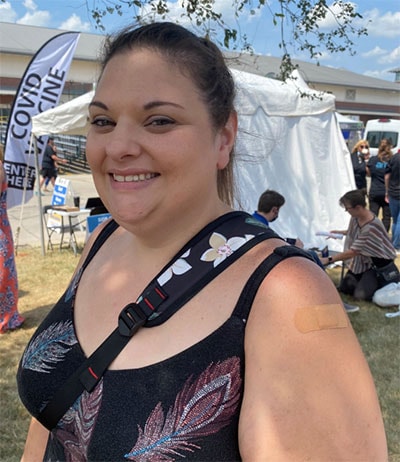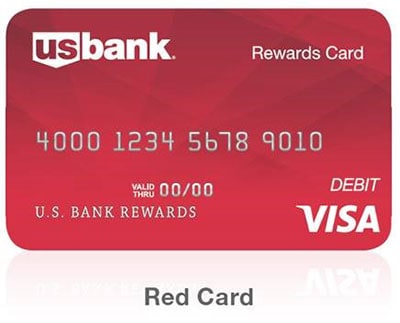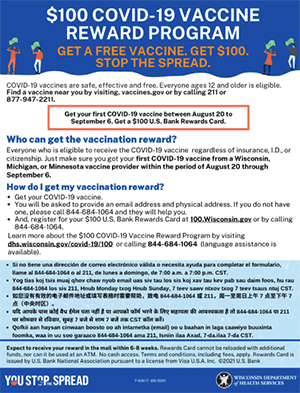Wisconsin Vaccine Incentive Program Motivates Thousands to Get Vaccinated in One Month

Wisconsin Resident Takes Advantage of Incentive Program
In August 2021, the COVID-19 Delta variant was spreading rapidly across Wisconsin. Governor Tony Evers, who supported the Centers for Disease Control and Prevention’s (CDC’s) guidance that vaccines were the best tools to help stop the spread of the virus, put an incentive program in place to help get more Wisconsin residents vaccinated against COVID-19. A program funded by the federal American Rescue Plan Act was swiftly put together by Evers’ administration. Residents who received their first dose of a COVID-19 vaccine were mailed a $100 gift card.
The communication and outreach for the incentive program was done both through news outreach (e.g., press releases, media interviews) and through vaccinators and community-based organizations working to ensure people had access to vaccines.
Gift Card Program Boosts Vaccination Efforts
“The incentive was for getting your first dose—to get individuals to initiate the vaccine series,” said Sarah Deering, the COVID-19 Communications Program Manager with the Wisconsin Department of Health Services (DHS). “However, we found that those who received the incentive were more likely than non-recipients to return for their second dose even though the incentive was not contingent upon that.”
Deering added, “Data show that non-recipients of the incentive were twice as likely to be overdue for their second shot as compared to incentive recipients. Reminders for the second dose were done by providers/clinics based on their own procedures.”
Mark Silva, COVID-19 Vaccine Administration Manager with Wisconsin DHS, said, “This program was developed very quickly—it was put together in less than 10 days—and was intended to create a sense of urgency and importance.”
Once Wisconsin DHS had the incentive plan in place, they used multiple channels to reach patients and partners. “We advertised the program to our local and tribal health departments and other partners through our weekly vaccine program webinar,” said Silva.
Health departments and providers used the state Immunization Information System (IIS) and their electronic medical records to identify and contact people eligible for the incentives and help plan for vaccination sites.

“The program was simple to implement,” Silva explained. “We worked with our partner, US Bank, to offer a reward card that would be mailed directly to participants at the address they entered into an online registration portal.” Registrations were validated using the state IIS, and confirmed participants received their cards in the mail several weeks later.
The incentive program was originally planned to run for 10 days, but due to significant participation, the program was extended for one month—from mid-August through mid-September. “We had over 80,000 participants,” said Silva.
Local organizations used the incentive as an opportunity to boost their own incentive programs. There were grocery and gas card incentives and other opportunities that made the state incentive more effective in some communities, according to Ceri Jenkins, the Planning and Implementation Program Manager with Wisconsin DHS.
Silva explained that the $100 amount wasn’t random. “We wanted to be careful not to offer too low of an incentive that folks wouldn’t be interested in receiving the vaccine, but we also found that anything over $100 might make folks suspicious or feel like they were being coerced into getting something they didn’t want.”
How successful was the incentive program?
Rob O’Connell is Data Analytics Program Coordinator for the COVID-19 Response and Recovery Team with Wisconsin DHS. “We analyzed 76,641 incentive recipient records at the state, county, and census tract levels,” he said.
Wisconsin DHS found:
- People ages 12–17 years participated at the highest level, compared to their portion of the state’s population. They are only 8% of the population but 18% of all incentive recipients.
- White residents participated significantly less compared to their portion of the state’s population; about 75% of recipients identified as White residents, as compared to White residents making up 87% of the state’s population.
- Slightly more of the Hispanic population participated than their portion of the state’s population; 8% of recipients identified as Hispanic residents, while Hispanic residents make up 7% of the state’s population.
- Several tribal communities had a significantly higher than average recipient rate, including Menominee, Bad River, and Oneida.
“In the rural northern part of the state, we didn’t have as deep a reach with the incentive, but in southeastern Wisconsin, we had a significant impact in communities that already had over six months to get vaccinated and had not done so,” Jenkins explained.
“The incentive may have afforded people the ability to budget for missed work hours or other costs associated with traveling to get a vaccine,” said O’Connell.
Silva emphasized the value of the incentive to families, “If you’re looking at a family of five who are all eligible for the reward, that’s $500, which can be used in many ways.”
Two years later, where do Wisconsin’s vaccination efforts stand?
As of August 2022, Wisconsin is 23rd among the states, with 66.7% of Wisconsin residents ages 5 years and older fully vaccinated, which is close to the US average.
At the same time, Wisconsin DHS indicates a large share of state residents are not up to date on their COVID-19 vaccines, and less than a third of eligible people have received a booster shot. Yet, for the ages 65 years and older group, Wisconsin’s rates are higher than national averages with more than 83% of residents ages 65 years and older having received a first booster dose as of August 2022, placing Wisconsin third in the nation at that age group.
To get more people vaccinated, Lauren Rieves, COVID-19 Vaccination Program Manager for Wisconsin DHS, was asked if the reminder/recall strategy was used. This strategy helps keep patients up to date with recommended vaccines and can help increase a clinic or organization’s immunization rates.
“We did not employ the recall reminder strategy at the state level,” said Rieves. “There were local jurisdictions that sent out reminders through the mail based on immunization records from their data registries. Wisconsin encouraged our healthcare partners to do it on their own. Based on their records, they can see if a patient is late for a second dose or a booster.”

Rieves added that more people need to be fully vaccinated. “There are some parts of the state like Dane County, which includes the city of Madison and the University of Wisconsin, where a higher percentage of residents are vaccinated, as well as some rural counties and certain areas of Milwaukee where vaccination rates are lower.“
“While we can’t make anybody get vaccinated, we can work to make sure the public has access to accurate information, trusted messengers, and data- informed messages. We do a lot to engage our broad network of providers and community partners.”
Working to Reduce Disparities in COVID-19 Vaccination
The COVID-19 pandemic has highlighted health inequities across the nation and in Wisconsin. Wisconsin DHS’s relationships with the state’s local health departments and 11 federally recognized tribal groups are key to addressing inequities.
Sarah Deering, the COVID-19 Communications Program Manager said, “The two-way communication that the response team and state DHS has built up with local and tribal health officers has been very important. There are regular meetings that continue to this day where local and tribal health officials can ask questions of the DHS communicable disease team.”
Evolving Communication Strategies
Working to reach as many audiences as possible remains a top priority. The department put together a digital media campaign regarding protecting yourself against COVID-19. “The average Wisconsinite saw a digital video ad from our campaign at least 10 times and the video was really important to reach Spanish language audiences. Parents were also very engaged with the video ads on social media,” said Deering.
She noted that one particularly influential social media network was Pinterest, which drove the strongest overall engagement across statewide audiences.
Yet, Deering notes that significant challenges remain. “Information and pandemic fatigue exist so how do we communicate effectively and deliver information to the public so they can take action that is relevant to their lives?” She adds they continue to navigate through all the shifting attitudes and misinformation, while partnering with trusted messengers and recognizing the range of attitudes toward government public health.
Tangible Results Bring Optimism
There are a lot of positives to come out of these two years. Rieves explains there has been strong relationship-building across Wisconsin. “The state is so much more connected with ‘boots on the ground’ and there’s significantly more cross-agency and cross-sector collaboration.”
Rieves feels optimistic now. “We have so many more tools in the toolbox with therapeutics, test to treat, and the vaccines… I think we are in a much better place to prevent hospitalizations and deaths. There’s so much more protection in place for our [public] health infrastructure.”
For more information, please see 12 COVID-19 Vaccination Strategies for Your Community
What are you, your health department, or your organization doing to support COVID-19 vaccination in your community? Share your story with communityfeatures@cdc.gov and you could see it on our COVID-19 Vaccine Community Features page.